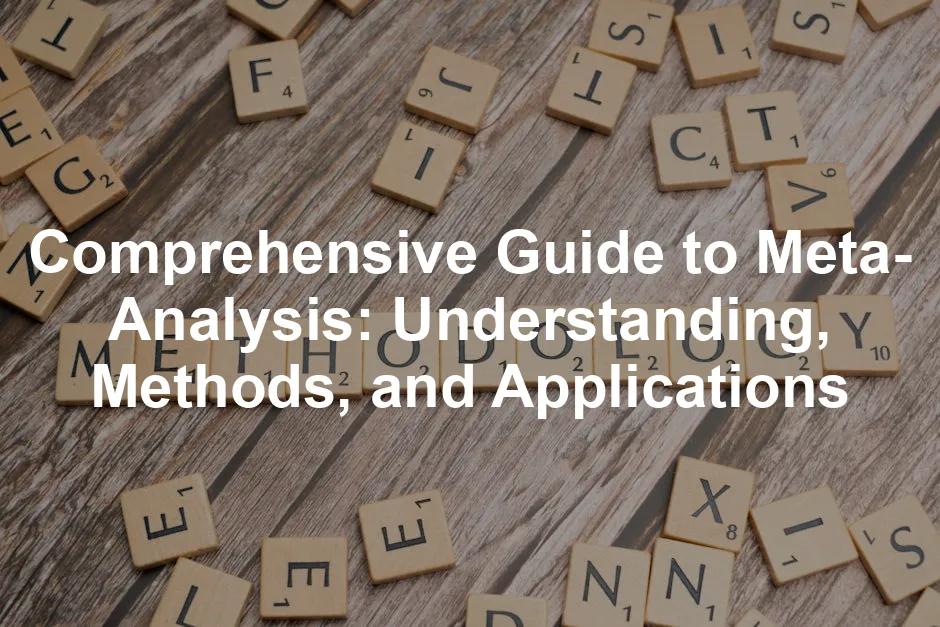Introduction
Meta-analysis is a statistical method that combines results from multiple studies. It plays a crucial role in synthesizing research findings. This article aims to explore its methodologies, applications, and best practices.
Summary and Overview
Meta-analysis serves as a powerful tool for synthesizing quantitative data. By aggregating results from various independent studies, it enhances statistical power and provides clearer insights. This approach is particularly valuable in addressing conflicting research findings, allowing researchers to resolve uncertainties. The systematic methodology behind meta-analysis has evolved since its introduction in the 1970s. Today, it encompasses diverse fields, including healthcare, psychology, and social sciences.

The evolution of meta-analysis methodologies has significantly impacted various fields, including healthcare.
The systematic approach ensures that all relevant studies are considered, leading to more reliable conclusions. As the body of research grows, the importance of meta-analysis in guiding future studies becomes increasingly evident. It not only informs clinical practices but also shapes research agendas, making it an essential component of evidence-based practice.
For those diving deeper into meta-analysis, consider picking up “Introduction to Meta-Analysis” by Michael Borenstein. It’s a fantastic resource for those looking to get a comprehensive understanding of this powerful statistical technique.
Understanding Meta-Analysis
Definition and Importance
Meta-analysis is defined as a quantitative method for combining results from different studies to arrive at a single conclusion. This statistical technique is crucial in evidence-based practice, enabling researchers to draw more reliable conclusions. The ability to analyze a larger dataset increases the robustness of findings, making it a vital tool in various fields.
Common applications include healthcare, where meta-analysis informs treatment guidelines and policies. In social sciences, it helps synthesize findings across studies to understand complex social phenomena. By integrating data from multiple studies, meta-analysis significantly enhances the quality of evidence available for decision-making.

To navigate the intricate world of research methods, “Research Design: Qualitative, Quantitative, and Mixed Methods Approaches” by Charles C. D. Creswell is a must-have. You can grab a copy here. It’s like having a research guru in your pocket!
Historical Context
Meta-analysis has a rich history, evolving significantly since its inception. The term “meta-analysis” was introduced in 1976 by statistician Gene Glass. He used it to describe the statistical analysis of analyses. Glass aimed to standardize the evaluation of research findings across studies. His work laid the groundwork for modern meta-analytic methods.
Before Glass, the foundations for aggregating research data were laid in the early 20th century. A notable example is a 1904 study by Karl Pearson, which aggregated results from multiple studies on typhoid inoculation. This early effort demonstrated the potential of combining results to draw broader conclusions.
The growth of meta-analysis accelerated in the 1980s and 1990s, particularly in healthcare and social sciences. Researchers recognized its value in addressing conflicting findings and enhancing the robustness of research conclusions. Key milestones include the establishment of guidelines for conducting meta-analyses, such as those from the Cochrane Collaboration. These guidelines have helped standardize practices and improve the quality of meta-analytic research.

Today, meta-analysis is a cornerstone in many fields. Its ability to synthesize evidence from diverse studies makes it an essential tool for researchers and practitioners alike. If you want to dive deeper into systematic reviews, the Cochrane Handbook for Systematic Reviews of Interventions is a comprehensive guide worth checking out!
Methodological Considerations
Literature Search
Conducting a thorough literature search is a critical first step in meta-analysis. It begins with defining appropriate keywords and search limits. This ensures you capture all relevant studies. A systematic approach is vital for reproducibility. Databases like PubMed, Cochrane Library, and Embase are commonly used for this purpose.
Once you initiate the search, you may encounter a large volume of studies. Here, inclusion and exclusion criteria come into play. These criteria help filter studies based on relevance and quality. For instance, you might exclude studies that don’t meet specific methodological standards. Documenting this process is essential. A PRISMA flow diagram is often used to outline how studies were selected and filtered. You can find a useful PRISMA Flow Diagram Template to assist you in this process.

It’s also crucial to consider the publication date and language of the studies. This helps ensure that the search is comprehensive. Finally, maintain clear records of your search strategy. This transparency allows others to replicate your work and strengthens the integrity of your meta-analysis.
Data Extraction and Quality Assessment
After identifying relevant studies, the next step is data extraction. This involves compiling key information from each study, such as sample sizes, effect sizes, and outcomes. A structured data extraction form can streamline this process. It ensures consistency and reduces the risk of missing important details.
Quality assessment is equally important. Evaluating the methodological quality of each study helps identify potential biases. Various tools and checklists exist for this purpose, such as the Cochrane Risk of Bias Assessment Tool. These tools assess factors like randomization, blinding, and attrition rates. Understanding the quality of included studies is crucial. Poor-quality studies can skew results and lead to misleading conclusions.

Ultimately, combining data from high-quality studies enhances the credibility of your meta-analysis. By ensuring rigorous data extraction and quality assessment, you lay a solid foundation for reliable findings.
Statistical Methods in Meta-Analysis
Fixed Effect Model
The fixed effect model assumes that all studies estimate the same underlying effect. In this model, each study’s result contributes to a weighted average. The weight is typically the inverse of the variance of each study’s effect size. This method is best used when studies are similar in terms of design and population. It works well when you expect minimal variability among studies. If you’re conducting a meta-analysis with well-defined, consistent results, the fixed effect model is appropriate.
Random Effects Model
The random effects model recognizes that different studies may estimate different effects. This model accounts for variability between studies, treating this variation as random. It allows for a broader application of findings. One significant advantage of the random effects model is its ability to generalize results across diverse studies. It is particularly useful when studies differ in methods or populations. This model often provides more conservative estimates, which can be beneficial when interpreting findings.

Effect Size Measures
Effect sizes quantify the strength of a relationship or the magnitude of an effect. Common types include odds ratios, mean differences, and standardized mean differences. Choosing the right effect size measure depends on your data type. For example, use mean differences for continuous data and odds ratios for binary outcomes. Selecting an appropriate measure ensures your results are meaningful and interpretable. Always consider the context of your studies when making this choice, as it can significantly impact your analysis.

Addressing Heterogeneity
Heterogeneity refers to the variation in study outcomes. It can arise from differences in study design, populations, or interventions. Assessing heterogeneity is crucial for accurate meta-analysis results. One method to evaluate heterogeneity is the I² statistic, which indicates the percentage of variation due to differences between studies. A high I² value suggests substantial heterogeneity, prompting further investigation. To manage heterogeneity, consider subgroup analyses or random effects models. These techniques help provide clearer insights and improve the robustness of your conclusions.

Applications of Meta-Analysis
In Clinical Research
Meta-analysis plays a pivotal role in clinical research. It aggregates data from multiple clinical trials to form robust healthcare guidelines. For instance, the meta-analysis of statin therapy has shown significant benefits in reducing cardiovascular events. Another notable example is a meta-analysis that assessed the efficacy of various treatments for hypertension, providing crucial insights for doctors.

These analyses inform treatment protocols and shape health policies. They allow healthcare professionals to base their decisions on a comprehensive view of the evidence. When conflicting results emerge from individual studies, meta-analysis helps clarify the overall effectiveness of interventions.
If you’re interested in understanding how to conduct your own meta-analysis, “Meta-Analysis in Medical Research: The Handbook for the Health Care Professional” by David G. Altman is an invaluable resource. You can find it here. It’s packed with useful insights!
In Social Sciences
Social sciences utilize meta-analysis to synthesize findings across diverse studies. This approach helps researchers understand complex social phenomena and trends. For example, a meta-analysis on the impact of socioeconomic status on educational attainment revealed consistent patterns across multiple contexts. This is an area where agresti statistical methods for the social sciences can be particularly beneficial.

Understanding how statistical methods apply in social sciences can enhance the effectiveness of meta-analysis. Learn more about Agresti’s statistical methods for the social sciences.
Another significant study examined the relationship between physical activity and mental health. By combining results from numerous investigations, researchers concluded that regular exercise significantly reduces depressive symptoms. These examples highlight how meta-analysis enhances knowledge in social research, guiding future studies.

In Ecology and Environmental Science
In ecology, meta-analysis has become increasingly important for environmental science. It evaluates the effects of various interventions on ecosystems. A prominent example is a meta-analysis that assessed the impact of conservation strategies on biodiversity. Such analyses provide valuable insights for policymakers.
Moreover, a meta-analysis on the effectiveness of reforestation efforts showed that tree planting significantly enhances carbon sequestration. This information is vital for shaping environmental policies and conservation efforts. By synthesizing ecological data, meta-analysis informs better management practices for natural resources.

Challenges and Limitations
Despite its benefits, meta-analysis faces several challenges. One significant issue is publication bias. This occurs when studies with positive results are more likely to be published, skewing the overall findings. Researchers must employ techniques to detect and mitigate this bias, such as using funnel plots.
The quality of included studies also impacts the validity of results. Combining studies with varying methodological standards can lead to misleading conclusions. Researchers need to assess the quality of each study before including it in the analysis.
Interpreting meta-analysis results can be complex. It’s essential to contextualize findings within the broader research landscape. Variability among studies, known as heterogeneity, can complicate interpretations. Addressing these challenges is crucial for conducting robust meta-analyses and ensuring reliable conclusions.

Publication Bias
Publication bias occurs when studies with significant results are more likely to be published. This skews the overall findings of a meta-analysis. For instance, if negative results go unpublished, the analysis may present an overly optimistic view of an intervention’s effectiveness. Detecting publication bias is essential. Researchers can use funnel plots to visualize this bias. Statistical tests, like Egger’s test, help quantify it. To mitigate publication bias, include both published and unpublished studies. This approach ensures a more balanced representation of evidence.

Quality of Included Studies
The quality of primary studies significantly impacts meta-analysis outcomes. High-quality studies contribute reliable data, while poor-quality studies can distort results. When integrating studies of different methodological standards, challenges arise. For example, combining randomized controlled trials with observational studies can lead to misleading conclusions. It’s vital to assess the methodological quality of each study before inclusion. Tools such as the Cochrane Risk of Bias Tool can assist in this evaluation. Focusing on robust studies enhances the credibility of your meta-analysis.
Interpretation of Results
Interpreting meta-analysis results can be challenging. Variability among studies, known as heterogeneity, complicates this process. Different study designs, populations, and interventions can lead to varying results. Contextualizing findings is crucial. A meta-analysis should not be viewed in isolation; it must be considered within the broader research landscape. Understanding the implications of heterogeneity helps in accurately interpreting results. Researchers should approach conclusions cautiously, ensuring they reflect the complexity of the evidence.
To enhance your writing skills while conducting research, consider investing in “On Writing Well: The Classic Guide to Writing Nonfiction” by William Zinsser. You can find it here. It’s a great resource for refining your writing style!
Please let us know what you think about our content by leaving a comment down below!
Thank you for reading till here 🙂
All images from Pexels




